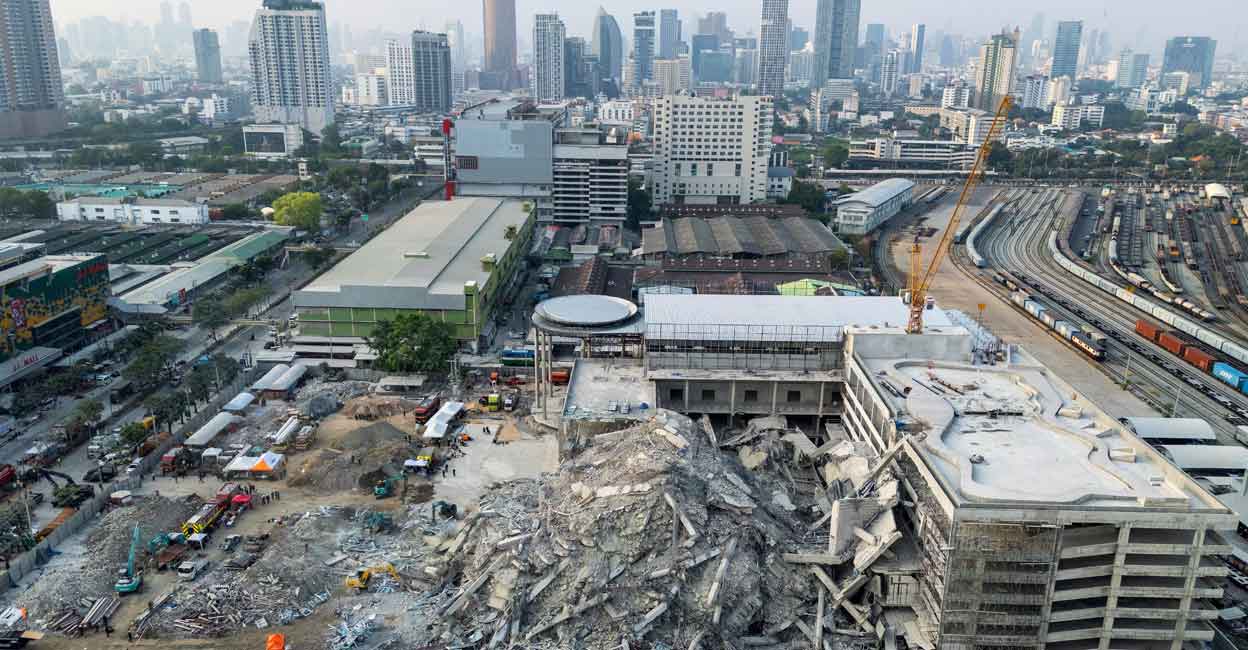Myanmar earthquake: Death toll rises to 1,000, over 1,670 injured

Mail This Article
The death toll from a huge earthquake that hit Myanmar and Thailand passed 1,000 on Saturday, as rescuers dug through the rubble of collapsed buildings in a desperate search for survivors. Over 1,670 were injured in the 7.7-magnitude quake, which struck northwest of Sagaing in central Myanmar on Friday, causing widespread destruction.
Rescue teams worked through the night, searching for survivors trapped under the rubble of collapsed buildings. The quake toppled structures, destroyed bridges, and buckled roads across Myanmar, with severe damage reported in Mandalay, the country’s second-largest city.
According to US geologists, it was the most powerful earthquake to hit Myanmar in over a century. The tremors were so strong that they caused significant structural damage in Bangkok, hundreds of kilometres away from the epicentre.
Rescue efforts in Bangkok
In Thailand’s capital, rescue workers sifted through the debris of a collapsed 30-storey skyscraper, which crumbled within seconds due to the quake’s force. Bangkok Governor Chadchart Sittipunt confirmed that at least 10 people had died in the city, most of them in the skyscraper collapse, but warned that up to 100 workers remained unaccounted for.
"We are doing our best with the resources we have because every life matters," Chadchart said. "Our priority is acting as quickly as possible to save them all."

Authorities in Bangkok deployed over 100 engineers to assess building safety after receiving more than 2,000 reports of damage. Up to 400 people spent the night in city parks as their homes were deemed unsafe.
While Bangkok did not suffer widespread destruction, dramatic scenes unfolded as rooftop swimming pools overflowed, spilling water down high-rise buildings. Even hospitals were affected—one woman gave birth outdoors after being evacuated, while a surgeon completed an operation outside after moving a patient from the operating room.
Myanmar declares state of emergency
The worst devastation was in Myanmar, where the ongoing civil war has left the country’s healthcare and emergency response systems severely weakened. Junta chief Min Aung Hlaing made a rare appeal for international aid, a striking move given that past military regimes have often refused foreign assistance even in times of crisis.
A state of emergency was declared across the six worst-affected regions. In Naypyidaw, the capital, overwhelmed hospitals were forced to treat the injured in the open air. "I’ve never seen anything like this before," one exhausted doctor told AFP. "We are trying to handle the situation, but it’s overwhelming."
Mandalay, home to more than 1.7 million people, was among the hardest-hit areas. Photos showed entire buildings reduced to rubble. A resident told AFP that a hospital and a hotel had been completely destroyed, and there was a severe shortage of rescue personnel.

On Saturday morning, a long queue of buses and lorries waited at a checkpoint to enter the capital, likely carrying aid and emergency supplies.
Offers of foreign assistance began pouring in. US President Donald Trump pledged support, telling reporters, "It's terrible… a really bad one, and we will be helping." India, France, and the European Union also offered aid, while the World Health Organization said it was mobilising trauma injury supplies.

